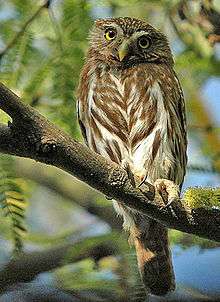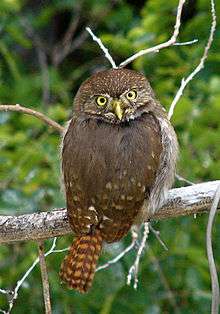Ferruginous pygmy owl
| Ferruginous pygmy owl | |
|---|---|
 | |
| Cactus ferruginous pygmy owl | |
| Scientific classification | |
| Kingdom: | Animalia |
| Phylum: | Chordata |
| Class: | Aves |
| Order: | Strigiformes |
| Family: | Strigidae |
| Genus: | Glaucidium |
| Species: | †G. brasilianum |
| Binomial name | |
| Glaucidium brasilianum (Gmelin, 1788) | |
The ferruginous pygmy owl (Glaucidium brasilianum) is a small owl that breeds in south-central Arizona in the United States, south through Mexico and Central America, to South America into Bolivia, Paraguay and Argentina.
In Central America and South America, it is the most widely distributed pygmy owl and is probably one of the most numerous owl species in those areas. It is found in a wide range of semi-open wooded habitats in these areas
Taxonomy
This species is a part of the larger family Strigidae of owls, known as typical owls. This family contains most species of owls.
Trinidad, as well as other localities, have endemic subspecies of the Glaucidium brasilianum owl. Recent genetics work has found substantial differences in ferruginous pygmy owls from different regions and members of the northern ridgwayi group are sometimes considered a separate species, the Ridgway's pygmy-owl (Glaucidium ridgwayi).
Description
This species is crepuscular, but often hunts by day. It hunts a variety of birds, lizards, mammals, and insects. The flight is low to the ground and rapid with long swoops.
It can be readily located by the small birds that mob it while it is perched in a tree (up to 40 birds of 11 species have been recorded mobbing one owl).
Appearance

The ferruginous pygmy owl is small, typically 15 cm (5.9 in), and stocky with disproportionately large talons. The crown has elongated white/buff spots or streaks, the wing coverts have white spots, and the underparts are heavily streaked white. There are prominent white supercilia above the facial disc. There are two eye spots on the nape.
Otherwise, its overall color is highly variable, ranging from grey-brown with a black-and-white barred tail to rich rufous with a uniform rufous tail. Sexes are similar with females slightly larger and often more reddish.
Call
The call is a whistled hoo-hoo-hoo-hoo, usually in E flat. It is easily imitated, and is used by birdwatchers to attract small birds intent on mobbing the pygmy owls.
Breeding and incubation
The Glaucidium brasilianum mating season is from late winter to early spring. It is a cavity nesting bird (tree and columnar cactus cavities), laying 3–5 white eggs. Incubation is 28 days, with 27–30 days to fledging.
Conservation
The northernmost subspecies, G. b. cactorum, commonly called the cactus ferruginous pygmy owl, was a listed Endangered species under the U.S. Endangered Species Act. This protected it in south-central Arizona from loss of habitat and buffel grass fires. Buffel grass catches fire very easy, which spreads to cacti, burning the owl's primary habitat.
Its range extends over the border into Sonora, Mexico. Glaucidium brasilianum was delisted in 2006.
References
- ↑ BirdLife International (2016). "Glaucidium brasilianum". The IUCN Red List of Threatened Species. IUCN. 2016: e.T61815999A95181606. doi:10.2305/IUCN.UK.2016-3.RLTS.T61815999A95181606.en. Retrieved 14 January 2018.
External links
| Wikimedia Commons has media related to Glaucidium brasilianum. |
| Wikispecies has information related to Glaucidium brasilianum |
- Ferruginous Pygmy Owl - Glaucidium brasilianum - USGS Patuxent Bird Identification InfoCenter
- "Ferruginous Pygmy Owl media". Internet Bird Collection.
- Cactus Ferruginous Pygmy Owl information and Photos
- Ferruginous Pygmy Owl Rescue
- Ferruginous Pygmy Owl Photos at peter-haefele.de
- Ferruginous Pygmy Owl photo gallery at VIREO (Drexel University)
- Ferruginous Pygmy Owl species account at NeotropicalBirds (Cornell University)
